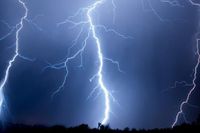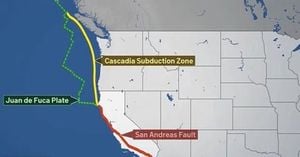Central Canada faced a dramatic return of heat and humidity on Thursday, July 24, 2025, sparking a series of severe thunderstorms that swept across Ontario and Quebec, leaving tens of thousands without power and raising concerns over potential tornadoes.
As the day unfolded, the atmosphere turned volatile. By 7:50 p.m., Hydro One reported that about 40,000 customers in Ontario were without electricity, a direct consequence of the intense weather system battering the region. Several lines of severe thunderstorms were expected to persist into the evening hours, driven by a combination of moisture, atmospheric instability, wind shear, and a triggering low-pressure system.
The main threats posed by these storms included hail, heavy downpours, and powerful wind gusts capable of causing significant damage. More alarmingly, meteorologists warned of the possibility of rotation within the storm cells, raising the risk of one or two tornadoes touching down in parts of northeastern Ontario, along the shores of Lake Huron and Georgian Bay, and into Quebec.
Environment Canada issued tornado warnings across multiple areas on Thursday afternoon. In southwestern Ontario, particularly around the Mitchell area, reports of damage began to surface, underscoring the severity of the storms. Quebec was not spared either; the same storm system swept through parts of the province, with wind damage reported late Thursday afternoon.
Conditions intensified between 7 and 8 p.m., when storms matured into a more linear pattern, increasing the likelihood of damaging wind gusts exceeding 90 to 100 kilometers per hour, especially along the Georgian Bay and Lake Huron shores. Thunderstorms were anticipated to reach the northern Greater Toronto Area late in the evening or overnight, though they were expected to weaken as the atmospheric energy diminished. Rainy periods were forecast to continue into Friday morning for parts of the GTA.
Early next week, weather conditions were expected to stabilize somewhat, with mostly sunny, hot, and humid days punctuated by a chance of passing thunderstorms. However, a strong cold front was predicted to move southward midweek, around July 30, bringing an increased risk of thunderstorms. By late next week, cooler air was forecast to settle in, with temperatures remaining below seasonal averages through the August long weekend and into the first week of August. A return to significantly warmer weather was anticipated for the second week of August.
Among the most closely watched areas was North Bay, where Environment Canada meteorologists tracked a severe thunderstorm capable of producing a tornado as of 5:00 p.m. The warning covered North Bay, Powassan, and Mattawa. Officials reported that damaging winds, large hail, and locally intense rainfall were possible, prompting an upgrade from an earlier thunderstorm warning to a tornado warning. The situation was described as dangerous and potentially life-threatening, with urgent calls for residents to take cover immediately if threatening weather approached.
At 5:32 p.m., the tornado warning for North Bay was downgraded to a severe thunderstorm watch, signaling some easing of the immediate threat but maintaining vigilance for dangerous conditions. Environment Canada advised that if residents heard a roaring sound, saw a funnel cloud, swirling debris near the ground, or flying debris, they should seek shelter indoors in a room on the lowest floor, away from windows and outside walls—preferably a basement, bathroom, stairwell, or interior closet. Mobile homes, vehicles, tents, trailers, and other temporary shelters were deemed unsafe, with recommendations to move to sturdy buildings if possible. As a last resort, lying in a low spot and protecting one’s head from flying debris was advised.
Earlier in the day, a tornado warning had also been issued for the Espanola and Killarney areas. At 3:16 p.m., meteorologists were tracking a severe thunderstorm there with the potential to produce a tornado, accompanied by damaging winds, large hail, and intense rainfall. A severe thunderstorm warning was simultaneously in effect for Greater Sudbury and its vicinity, where strong wind gusts, pea to dime-sized hail, and heavy rain were expected. By 8:50 p.m., both the tornado and severe thunderstorm warnings for these areas had been lifted.
The dangers posed by these storms were underscored by repeated reminders from Environment Canada and Emergency Management Ontario that lightning kills and injures Canadians every year. The advice was clear: "When thunder roars, go indoors!" The public was urged to remain alert to weather watches and warnings and to take immediate shelter if severe weather threatened.
This spate of severe weather serves as a stark reminder of the volatility of summer weather patterns in Central Canada. The combination of heat, humidity, and atmospheric dynamics created a perfect storm scenario, challenging both residents and emergency services alike. As the region braces for cooler temperatures in the coming weeks, the recent events highlight the importance of preparedness and respect for nature’s power.




